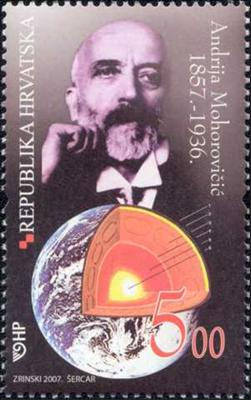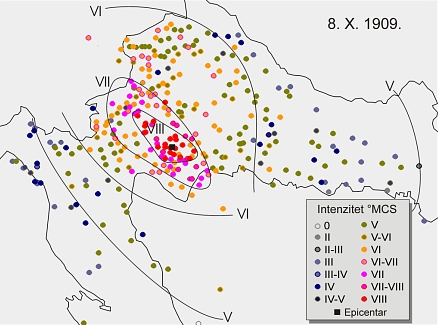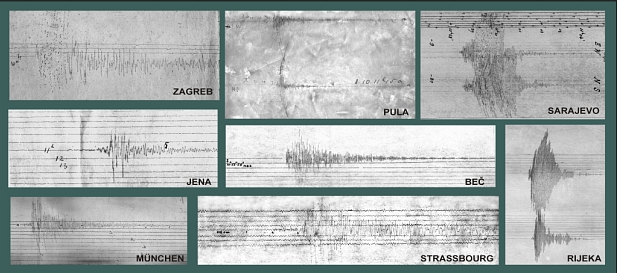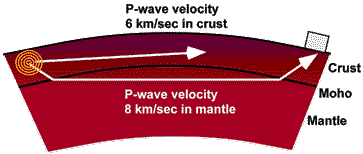
Croatian stamp created to honor Mohorovicic for being an accomplished scientist of his time.
Image Source: http://www.posta.hr/main.aspx?id=193&idmarke=1354
Biographical Information
Born on January 23, 1857 in Volosko (western Croatia), Andrya Mohorovicic was one of the major meteorologists and seismologists of the nineteenth and twentieth centuries. Andrya's father was a blacksmith and Andrya was also in love with the sea. He married the captain's daughter and they had four sons together. After secondary school, Andrya studied math and physics in Prague and then became a teacher upon graduating and taught from 1879 to 1893 in various grammer and secondary schools. He became the head of the Meteorological Observatory in Zagreb in 1892. Andrya received a doctorate in philosophy in 1893 and in 1910 became an associate university professor. He then taught geophysics and astronomy at the university level and became a member of the Yugoslav Academy of Sciences and Arts. He retired in 1921 and passed away 15 years later in 1936.
Specific contributions to plate tectonic theory / solid Earth geophysics
In 1909, Andrya studied the Pokuplje earthquake and the seismic P-waves associated with this event.

1909 Pokuplje earthquake intensity
Image Source: http://www.gfz.hr/sobe-en/discontinuity.htm

Gathered seismograph data from various stations during the 1909 Pokuplje earthquake.
Image Source: http://www.gfz.hr/sobe-en/discontinuity.htm.
Andrya Mohorovicic determined the boundary between the crust and the mantle, which is now named the Mohorovicic discontinuity. Velocities of seismic waves were used to identify this boundary. He had seismographs installed before the 1909 earthquake had occurred. His studies after the earthquake showed that there were two types of waves generated from an earthquake that pass through solid material. The waves are reflected and refracted when they come to a boundary between two types of material - in other words, the boundary between the crust and the mantle. Throughout the mantle, seismic waves have a greater velocity than through the crust. The amount of time various waves took to reach different stations allowed Mohorovicic to determine the depth of this boundary layer. Andrya studied all continents and oceans and determined that this discontinuity is present at all locations. He also came up with a function used to calculate the increasing velocity of seismic waves with increasing depth. This function is now known as Mohorovicic's law.

Illustration showing the "Moho" or Mohorovicic discontinuity between the crust and the mantle. This image also shows the velocities between P-waves traveling in the crust and the mantle.
Image Source: http://www.earthscrust.org/science/historic/andrija.html
Image showing the P-wave and S-wave curves and travel time.
Image source: http://srl.geoscienceworld.org/content/78/6/671/F2.large.jpg
Other interesting scientific contributions
1887, created his own meteorological station located in Bakar. He also created a nephascope, which was an instrument that aided him in determining the speed and direction of the clouds. His observations and discoveries as to the movement of anticyclones, cyclones, thunderstorms, and tornadoes are still used today to determine the patterns of storm systems.
1892, calculated precise time by making observations of stars that pass through the Gric median.
1893: established meteorological stations to track thunderstorms.
1899: created hail defense stations. (I was dissapointed to research webpage after webpage and none of them detailed what the hail defense stations were. I also did not find any record of hail defense stations in use today.)
1901: wrote a paper detailing the temperature drop with increased height.
Other cool stuff you should know
Andrya created the Zagreb school of seismology.
He created the Croatian meteorological survey and the Croatian seismological survey.
Mohorovicic also created a time service for the public in Croatia.
In 1970, a crater on the dark side of the moon was named after Andrya to honor his scientific contributions.
In 1996, an asteroid (#8422) was named in his honor.
His name is also used on Mars and the moon to describe the boundary between the crust and the mantle.
Many schools, universities, streets, cities, etc... are named in his honor.
- The locations that are named after Mohorovicic are in Croatia and include a gym and the school ship of the Croatian Navy.
Bibliography
Andrija Mohorovicic's memorial rooms: Andrija Mohorovicic's Biography. [Internet] Released 9.11.2005. Andrija Mohorovicic's memorial rooms. [Updated 2005; Cited 29 May 2012] Available from: http://www.gfz.hr/sobe-en/andrija.htm.
Andrija Mohorovicic's memorial rooms: Mohorovicic Discontuity. [Internet] Released 9.11.2005. Andrija Mohorovicic's memorial rooms. [Updated 2005; Cited 29 May 2012] Available from: http://www.gfz.hr/sobe-en/discontinuity.htm.
Herak, D. and Herak, M: Andrija Mohorovičić (1857-1936)—On the occasion of the 150th anniversary of his birth: [Internet] Released 11.01.07. Seismological Research Letters. [Updated 2012; Cited 3 June 2012]. Available from: http://srl.geoscienceworld.org/content/78/6/671.full?sid=787a220c-efd1-4d5c-be23-160500e64588.
Horvatska Posta: Famous Croats: Andrija Mohorovicic. [Internet] Released 23.4.07. Harvatska Posta. [Updated 2005; Cited 27 May 2012] Available from: http://www.posta.hr/main.aspx?id=193&idmarke=1354.
IGCP Project 559 - History: Andrija Mohorovicic (1857-1936) - defining the Earth's crust. [Internet] Released 13.10.2010. Crustal Architecture and Images. [Updated 2010; Cited 28 May 2012] Available from: http://www.earthscrust.org/science/historic/andrija.html.
USGS: Andrija Mohorovicic. [Internet] Released 27.10.05. USGS. [Updated 2005; Cited 28 May 2012] Available from: http://earthquake.usgs.gov/learn/topics/people/mohorovicic.php